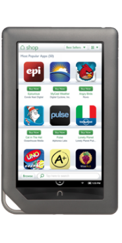
This article will discuss the different pricing models that are currently available and the pros and cons to each; subscription-based, patron-driven acquisitions, short term loans, access-to-own, etc. as well as strategies for controlling costs, and questions to ask before choosing an eBook solution.
Pricing Models
Just as there are an array of choices for how to go about purchasing eBooks, there are a myriad of lending and pricing models to navigate.
Ownership Model
Libraries can purchase books outright and then make them available to their patrons. This is the sole model for the Lexis Digital Library and the other OverDrive Collections.
Aggregators such as EBSCO and ProQuest will also enable you to purchase books and add them to your collection, but they oftentimes do so with additional options such as:
Short term loans: (STLs) – aka rentals, pay per use, pay per view. Patrons can borrow titles from the aggregator’s catalog that the library doesn’t own for a short term period such as 1-28 days. The library is charged for a rental of the book and it (theoretically) costs the library less than buying the book. Short-term loans initially ranged anywhere from 5%-30% of the title price of an eBook and it used to be an excellent way to see if a title was popular enough to warrant a purchase. Libraries could set their options to rent a book out three or four times before automatically purchasing the title for example without losing money. However, publishers have raised the cost of STLs so much over the past few years – some are now at 50%-75% of the cost of the book – that this is no longer a viable option.
Access-to-Own: (ATO) – ProQuest has developed a unique program in response to the recent publisher rate increases on STLs. They call it the Access-to-Own model which offers libraries the opportunity to have the money spent on short-term loans count towards the ownership of the eBook. Most major publishers (nearly 300) have agreed to this new model and they now have nearly 400,000 titles that adhere to the model. The way it works is that Front List Titles (Newly published within the past 12 months) will cost slight more with the first STL costing 55% of the cost of the book and the second STL costing 55% of the cost of the book. Through this model libraries will pay a 10% premium on the total cost of the book but will own it after 2 rentals (STLs). Likewise for Back List Titles (Publications older than one year), the first STL will cost 35% of the cost of the book, the second will cost 35% of the cost of the book, and the third STL will also cost 35% of the cost of the book. Libraries will pay a 5% premium on the total cost of the book but will own it after 3 rentals (STLs).
Ownership Based on Number of Users
Aggregators will offer different prices for books based on how many people will be allowed to read it at the same time.
- Unlimited Users (UU)
- Three User (3U)
- One User (1U)
Non-Linear Lending (NLL) and Concurrent Access Model (CAM)
ProQuest’s EBL program has an offering called non-linear lending (NLL). While some eBook vendors only provide single user access to eBooks so only one user can download and use each eBook at a time, these (non-linear lending (NLL) eBooks are available to unlimited users simultaneously. Usage is limited to a total number of loan days per year which 325 days. So, for example if 100 people checked out the same eBook for a 1-day loan, that eBook title would be available for 225 more days in that calendar year. After those loan days are used, the library must either purchase another copy or just make it available via STL. EBSCO has the same offering however it’s called the Concurrent Access Model (CAM).
Subscription Model
Both ProQuest and EBSCO have subscription models available in which libraries subscribe to a pre-packaged collection of eBooks for a flat fee per year. Nothing is owned by the library and access to eBooks remains dependent upon keeping up the library’s annual subscription. Both major aggregators offer hundreds of thousands of titles in collections specifically geared toward academic, corporate, government, medical, public, and school libraries. It should also be noted that subscriptions can also be combined with ownership and PDA models with both EBSCO and ProQuest.
Patron-Driven Acquisitions Model – PDA aka DDA (Demand-Driven Acquisitions) – The idea behind this model is that libraries can offer their users instant access to a very large collection of eBooks that they haven’t actually bought yet. Libraries don’t accrue any charges until patrons check the books out. At that point, according to the settings that they’ve chosen for their program, they will be charged with either the purchase of an eBook or a short-term loan. In this way, the library can make their purchase decisions based on what their patrons actually want and need. The way it works is that the library provides access to a curated range of hundreds or even thousands of titles which they decide upon based on all sorts of criteria such as price, publisher, etc. What happens next is the library can specify that they want to allow mediated or unmediated access to their books. So, if a patrons wants access to a book, a mediated request can be sent to the library and librarians have an option to purchase the book for the patron, OR the patron can get an instant, unmediated loan of the book in which it is either purchased or rented behind-the-scenes. The library can set up their account so that books are purchased automatically, or after a certain number of STLs, or not at all with only rentals occurring.


Strategies for Controlling Costs
Libraries have many options at their disposal to control and limit their costs once they’ve decided on an eBook program. Aggregators such as ProQuest and EBSCO offer detailed, up-to-the-minute reports in an administrative dashboard as well as full access to settings controlling the eBook collection at all times, and full access to monitoring all activity of the eBook collection at all times. If you decide on an ownership or an open-ended PDA lending model, you have these types of options at your fingertips through your dashboard:
- Switch from an unmediated to a fully mediated access model in which librarians will determine what’s purchased based on patron requests.
- Set a price limit on all short-term loans
- Set eBooks to auto-purchase when STL is equal to a certain percentage of the full cost of the book
- Set a shorter STL loan period for smaller cost
- Reset the trigger point for automatic purchases to occur sooner so less is spent on loans
- Do away with purchasing and only renting titles (STLs only)
- Limit the number of STLs per patron per day
- Reduce the number of eBook titles that are visible to patrons to choose from
- Remove publishers from the library’s profile that have raised their STL rates too much
- Only offer titles that adhere to the Access-to-Own pricing model
Questions You Should Ask Before Choosing an eBook Solution
Before you sign on the dotted line, here’s a brief checklist of questions you’ll want to be sure you’ve gotten the answers to.
Technical Requirements
- Browser compatibility – Is the eBook interface compatible with all browsers
- Plugins or software required? – What kind of software (likely Adobe Digital Editions) installation is required?
- Device compatibility? – Are these eBooks readable on all major eBook devices?
- Does the vendor offer EPUB format? – EPUB is the most compatible format for eBook readers, what type of format(s) does the vendor offer?
- Reports available? – Can the library monitor eBook loans and charges, etc?
Content
- Scope – What’s the scope of the collection and does that fit the library’s acquisitions policy?
- Number of titles – How many titles does the collection have, how many related to the field of law, etc.?
- Number of publishers – How many publishers does the collection aggregate and is that number going to increase?
- MARC records? – Will the MARC records be provided for the library free of charge?
- Embargo period? – Is there an embargo period set by the publishers on new titles?
Functionality
- Copy/Paste – Can users copy and paste from the text? If so, how much?
- Printing – Can users print? If so, how many pages?
- Search – Is there a full-text search within the eBooks available? A full-text search across the collection?
- Reading – Can eBooks be easily download for offline reading?
- Annotations – Are annotations, bookmarks, and other extra functionality possible?
Pricing Model
- Platform fee – Is there an annual, one-time setup, or platform fee involved? Can it be waived if a certain amount is spent each year?
- Lending Model – Are eBooks available for single or multiple or unlimited use?
- Title cost relative to print cost – Is there an additional cost for eBooks above the cost of a print title?
- Perpetual access – Will the library have perpetual access to eBook even if they cancel their account?
- Subscription available – Is there a subscription package available?
- Short term loans – Are STLs available?
- Patron-driven acquisitions – Is there a PDA model available?
- Free viewing period – If a PDA model, is there a free preview period for patrons to decide if they actually want to borrow the eBook?
- Minimum commitment – Is the library committed to spending a certain amount per year?
- Pricing discounts for consortia – Does the vendor have any discounts if the library signs through a consortia?
The next article will discuss our hybrid model at NYLI and how we’re utilizing aggregators and individual publisher platforms as well as subscription models and patron-driven acquisitions to create the largest and most comprehensive eBook collection of any membership law library in the US. If you missed Part One: The Landscape, it describes the current landscape of eBooks relevant to the law library field, the benefits of challenges of offering eBooks in law libraries, the different ways to purchase law-related eBooks, and how to get started choosing a solution.
